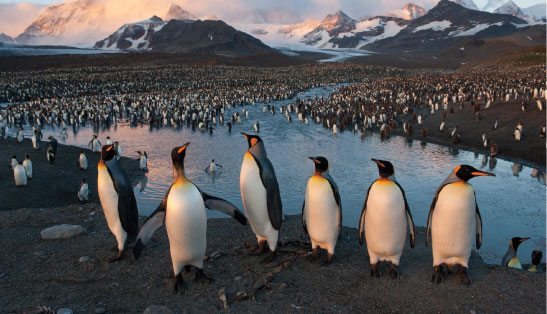It is summer in Antarctica. Frigid temperatures have been replaced by mild, 50-degree days.
Surrounded by green hills rolling into lush, snow-capped mountains and thick fog, Joel Sartore is crouching low to the ground. Usually, it is he who is chasing his subjects, but this time the tables have turned. Instead, in the middle of the beach-like terrain, Sartore is surrounded — by penguins. King penguins to be exact.
“Most of the time the animals I’m seeing are running away, they don’t want anything to do with me,” Sartore says, adding that the King penguins did the exact opposite. “They just wanted to stare at me. I got low on the ground and they stood right over me and looked at me. The whole thing was just tranquil, peaceful, and one of the most impressive things I’ve ever been a part of.”
Most of us will never get the chance to experience such an event. But for Sartore, it’s just another day on the job. From Antarctica to Russia, he has seen it all. Throughout his 20-year career working as a photographer for National Geographic, Sartore has traversed the globe, photographing everything from rare wildlife to hurricane aftermath and even state fairs.
“Once I discovered photography, there was never any turning back for me,” he says.
Sartore’s impressive body of work has been featured in Time, Life, Newsweek and Sports Illustrated. He also has contributed to several book projects and has been the subject of national broadcasts.
In addition to his talents as a photographer, Sartore devotes his energy to conservation efforts. A Nebraska native, he is committed to conservation in the Great Plains, is co-founder of the Grassland Foundation, and a founding member of the International League of Conservation Photographers.
Sartore will share his passion for sustainability as the speaker at Valley Forward’s 41st Annual Luncheon on Dec. 3.
“That is just an excellent group. There needs to be 100 groups like them. We have to start talking about this stuff and realizing that it’s easy to be green. It’s certainly a better way to live your life,” Sartore says. “There needs to be more and more people thinking and caring about the earth. We don’t have the luxury of time to count on the next generation to start saving the planet. We have to be doing it now.”
Sartore addresses the global environmental crisis using photography as his platform.
“I really am constantly faced with environmental problems,” says Sartore, a self-professed hyperactive person. “My job is to get people to think.”
While photographing the American Gulf Coast during one of his first assignments for National Geographic, Sartore was drawn to the plight of animals and the environment.
“I remember walking the beach and the bottom of my feet were black with spilled tar and oil, and there was garbage and a dead dolphin wrapped in plastic,” he says. “When you see things like that it makes you think that we could be doing a lot of things better, could be treating the Earth better.”
Sartore’s focus on building a sustainable future has allowed him to draw attention to issues that are often overlooked. His latest book, “Rare: Portraits of America’s Endangered Species,” sheds light on some of the country’s most endangered species of plants and animals, and what the public can do to help. “Rare” was originally inspired by a magazine assignment, before turning into a personal project for Sartore and later a full-fledged book.
Several of the subjects featured in the book were shot in Arizona, including the California condor, photographed at the Phoenix Zoo; and the Tarahumara leopard frog, photographed at the Arizona Sonora Desert Museum in Tucson.
Although, sadly, one of the other animals featured in the book, the Columbia Basin pygmy rabbit, became extinct during the book’s production, Sartore emphasizes the importance of highlighting environmental issues.
“It was a very good experience to give a voice for the voiceless,” Sartore says. “The encouraging thing is that most species in the book could make it if we pay attention to it. I guess that’s what I try to convey to people: There’s always hope. These things are absolutely worth saving.”
Sartore’s passion for photography began in high school and continued into college, where he earned a degree in journalism with an emphasis in photojournalism from the University of Nebraska. Thanks to some great mentors, Sartore decided to pursue a career in photography, but he didn’t forget his journalism roots.
“In any of these situations I go into, I bring with me a reporter’s aesthetic and background to it,” he says.
This background has proven beneficial, as he shoots such a wide variety of subjects in exotic locations around the world.
“I want to know why things are the way they are and how to fix it,” he says.
As thrilling as his job may be, it comes with its share of dangers. When asked how many times has he almost been killed, Sartore responds on his website: “More than I care to tell my wife about for sure.”
He hasn’t let the danger stop him, but he does try to err on the side of caution.
“You can’t take more pictures if you’re dead,” he writes.
Sartore continues to journey around the globe in search of the next great photo. Currently, he’s preparing to travel to Africa for an assignment. Despite two decades of experience under his belt, Sartore still worries.
“I’m very nervous that I’ll fail, starve and die, in that order,” he says. Irrational fear or secret to success? Maybe worrying is just part of the job, Sartore adds.
“Everything has worked out well so far, yet I’ve always been very worried that nothing ever would,” he says. “With a strong story you may just reach those people who can change the world. If I can right a few wrongs, then that’s probably a life well spent.”
-
If You Go:
Valley Forward’s 41st Annual Luncheon
11:30 a.m.-1:30 p.m.
Dec. 3
Hyatt Regency Phoenix
122 N. Second St., Phoenix
Reservations: info@valleyforward.org; (602) 240-2408




